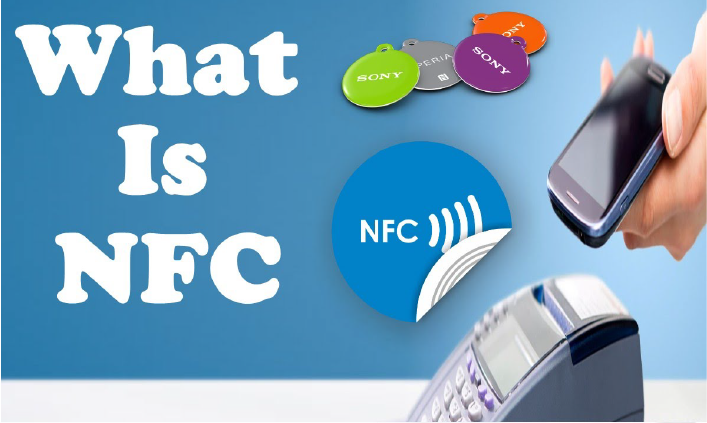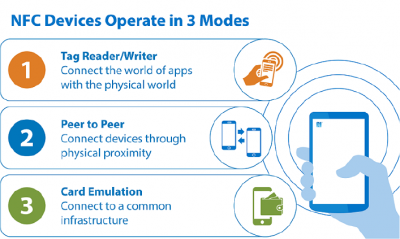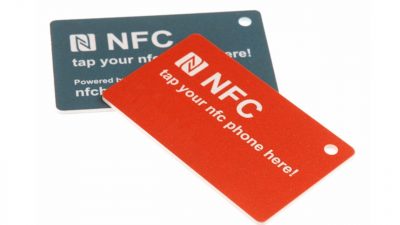NFC Technology
Near Field Communication (NFC) was born as a specialized subset of the 13.56MHz RFID technology in 2002. Initially used for access control and public transport payment cards, the integration into credit / debit cards and smartphones is driving rapid growth not only for payment, but also as an always-on radio link for simple pairing, diagnostic readout, parameter programming and much more.
The devices include NFC / RFID tags, Dynamic NFC tags, NFC / RFID readers & NFC controllers, including secure element for secure NFC applications and turnkey solutions.
The strength of NFC deployment lies in the fast, seamless, secure way–via a simple tap–people connect their smartphone with physical media and objects to establish all kinds of communications. By thoroughly connecting the physical to the digital worlds, NFC can implement entirely unique brand-consumer experiences and find its way into new industry applications such as interactive advertising, consumer activation and engagement, loyalty schemes, as accurately as on-package and on-product information sharing. Also, any content in the field can transform dynamically in the back end, so it stands sharp and relevant. Because NFC lets you gather data about each interaction, it’s also a valuable source of insights into consumer behavior.
Near Field Communications (NFC) is a type of radio-frequency technology that allows electronic devices—such as computers, mobile phones, tags, and others—to exchange information wirelessly across a small distance. NFC technology and its applications in the modern era. We discuss the potential use of NFC in the advancement.
Similar to other identification technologies, such as radio-frequency identification (RFID),
barcodes, and QR codes, near-field communication (NFC) is a short-range (4–10 cm) wireless
Communication technology.
NFC is based on the existing 13.56 MHZ RFID contactless card standards which have been established for several years and used for payment, ticketing,
Electronic passport, and access control among many other applications. Data rates range from 106 to 424 kilobits per second. A few NFC devices can support up to 848 kilobits
per second, which is now being considered for inclusion in the NFC Forum specifications.
Compared to other wireless communication technologies, NFC is designed for proximity or short-range communication, which provides a dedicated read zone and some inherent security. Its 13.56 MHz frequency places it within the ISM band, which is available worldwide. It is a bi-directional communication, meaning that you can exchange data in both directions with a typical range of 4 –10 cm depending on the antenna geometry and the output power.
NFC is convenient and fast: the automatically triggered action when your phone comes within 10 cm near the NFC tag and you get instant access to the content on mobile, without a single click.
RFID and NFC technologies are similar in that both use radio waves. Both RFID and NFC
Technologies exchange data within electronic devices in active mode and in passive mode. In
the active mode, outgoing signals are basically those that actually come from the power source,
whereas in se of passive u mode, the signals use the reflected energy they have received from the
active signal. In RFID technology the radio waves can send information to receivers up to
hundreds of meters away, depending on the frequency of the band used by the tag. If provided
with an outrageous amount of power, they can also send these signals to extreme distances with
airport radar. At large airports it typically controls traffic within a radius of 100 kilometers of the Airport below an elevation of 25,000 feet. Something also used very often RFID in tracking animals and vehicles.
In contrast, items like passports and payment cards should not be capable of long-distance transmissions because of the threat of theft of personal information or funds. NFC meets this need. NFC tags are very small in size to fit on the inner side of devices and products such as inside luggage, purses and packs as well as from inside wallets and clothing and can track. The NFC technology has added security features that make it much more secure than the previously popular RFID equivalent, and it is difficult to steal information stored in it. NFC has a short range of work area compared to other wireless technologies, so it can widely use for payments, ticketing and service admittance and thus has proved to be a safer technology. It is because of this security feature that we use this technology in cellular phones to turn them into a wallet.4 Both RFID and NFC wireless technologies can operate in active and passive communication modes to exchange data within electronic devices. The fundamental differences between NFC and RFID are:
- Though both RFID and NFC use radio frequencies for communication, NFC can be said to be an extension of the RFID technology. The RFID technology has been in use for more than a decade, but NFC has emerged on the scene recently.
- RFID has a wider range, whereas NFC has limited communication and operates only at proximity. NFC typically has a range of a few centimeters.
- RFID can function in many frequencies and many standards are being used, but NFC requires a fixed frequency of 13.56 MHz, and some other fixed technical specifications to function properly.
- RFID technology can be used for such applications as item tracking, automated toll collecting on roads, vehicle movement, etc., that require wide area signals. NFC is appropriate for applications that carry data that needs to be kept secure, like mobile payments, access controls, etc., that carry sensitive information.
- RFID operates over long distances while exchanging data wirelessly, so it is not secure for the applications that store personalized data. RFID using items susceptible to various fraud attacks, such as data corruption. NFC’s short working range considerably reduces this risk of data theft, eavesdropping, and “man in the middle” attacks.
- NFC can communicate both ways and thus is suitable to be used for advanced interactions such as card emulation and peer-to-peer sharing.
- It can scan simultaneously Several RFID tags, while it can scan only a single NFC tag at a time.
The extended functionality of a traditional RFID system has led to the NFC Forum. The NFC Forum has defined three operating modes for NFC devices: tag reader/writer mode; peer-to-peer mode, and card emulation mode. The NFC Forum technical specifications for the different operating modes are based on the ISO/IEC 18092 NFC IP-1, JIS X 6319-4, and ISO/IEC 14443. These specifications must be used to derive the full benefit from the capabilities of NFC technology. Contactless smart card standards are referred to as NFC-A, NFC-B, and NFC-F in NFC Forum specifications.
The extended functionality of a traditional RFID system has led to the NFC Forum. The NFC Forum has defined three operating modes for NFC devices: tag reader/writer mode; peer-to-peer mode, and card emulation mode. The NFC Forum technical specifications for the different operating modes are based on the ISO/IEC 18092 NFC IP-1, JIS X 6319-4, and ISO/IEC 14443. These specifications must be used to derive the full benefit from the capabilities of NFC technology. Contactless smart card standards are referred to as NFC-A, NFC-B, and NFC-F in NFC Forum specifications.
Peer-to-Peer Mode In peer-to-peer mode, both devices must be NFC-enabled for them to communicate with each other to exchange information and to share files. The users of NFC enabled devices can thus quickly share information and other files with a touch. As an example, users can exchange data such as digital photos or virtual business cards via Bluetooth or Wi-Fi.
Peer-to-peer mode is based on the NFC Forum’s Logical Link Control Protocol Specification and is standardized on the ISO/IEC 18092 standard. Card-Emulation Mode In card-emulation mode, an NFC device behaves like a contactless smart card so that users can perform transactions such as purchases, ticketing, and transit access control with just a touch. An NFC device may have the ability to emulate more than one card. In card-emulation mode, an NFC-enabled device communicates with an external reader much like a traditional contactless smart card. This allows contactless payments and ticketing by NFC-enabled devices without changing the existing infrastructure.
By adding NFC to a contactless infrastructure, one can enable two-way communications. In the air transport sector, this could simplify many operations, such as updating seat information while boarding or adding frequent flyer points while making a payment.
NFC Tags is a small microchip embedded in a sticker or wristband that can be read by the mobile devices that are within range. Information regarding the item is stored in these microchips. An NFC tag has the capability to send the information stored on it to NFC enabled mobile phones. NFC tags can also perform various actions, such as changing the settings of handsets or even launch a website. Tag memory capacity varies by the type of tag. For example, a tag may store a phone number or a URL. The most common use of the NFC tag function on an object is mobile wallet payment processing, where the user swipes or flicks a mobile phone on a NFC tag to make payment. Google’s version of this system is Google Wallet.
Being STMicroelectronics one of the pioneers of RFID and NFC technology, ST offers a comprehensive range of HF RFID/NFC products, covering all NFC application needs, supported by a rich ecosystem.
NXP Semiconductors is a leading manufacturer for NFC and RFID chips. The SmartCard America is a proud partners of NXP Semiconductors and STMicroelectronics and supporting many Smart City projects around the world.
Source:




